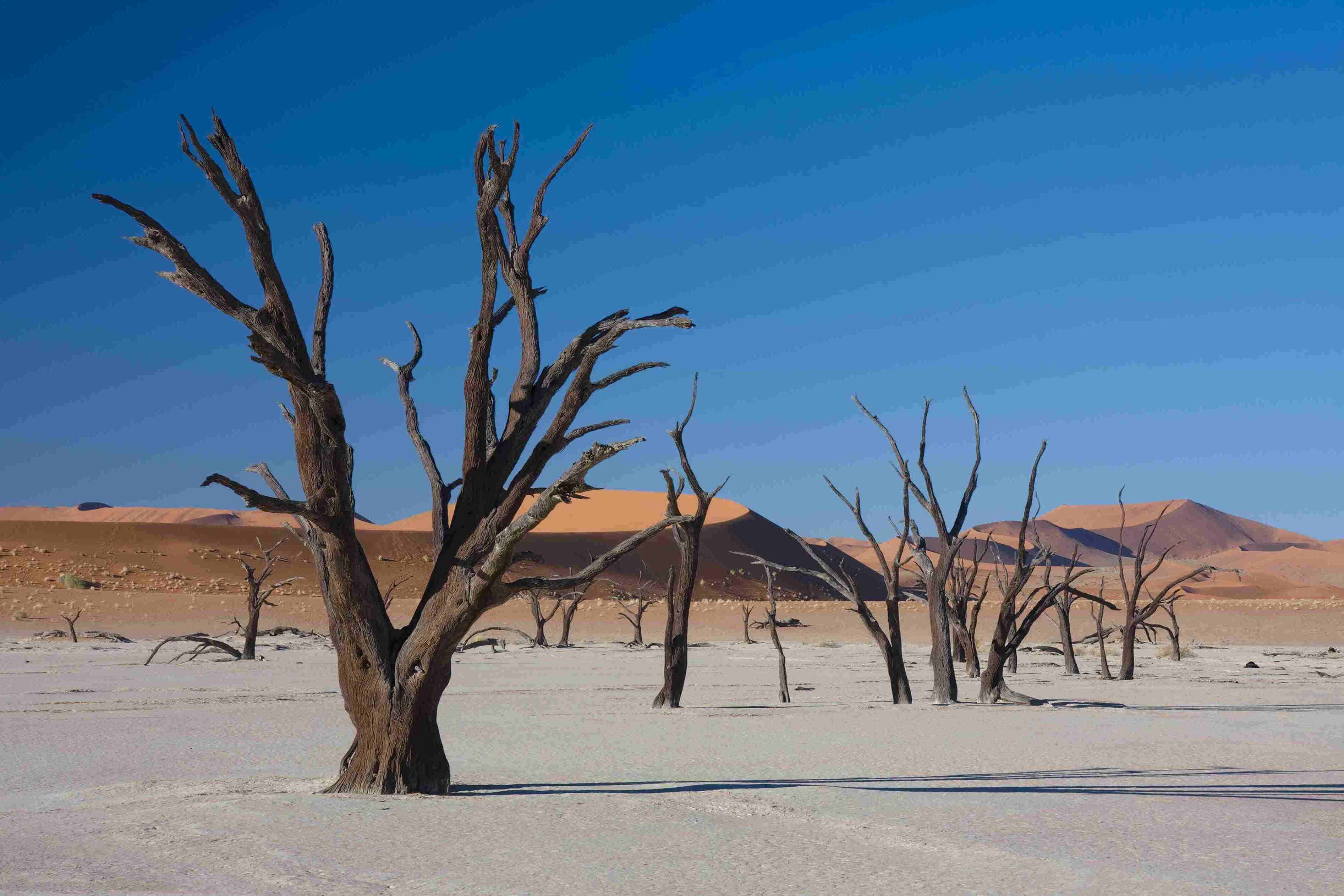Mystery Of Deadvlei’s White Clay And Dead Trees

Have you ever wondered why Deadvlei's white clay and dead trees create such a striking landscape? This unique spot in Namibia's Namib-Naukluft Park looks like something from another world. The bright white clay pan contrasts sharply with the dark, dead camel thorn trees, creating an eerie yet beautiful scene. These trees have stood lifeless for over 900 years, preserved by the dry climate. The clay pan itself formed when the Tsauchab River flooded, creating temporary shallow pools. Over time, the climate changed, and the area dried up, leaving behind this surreal landscape. Let's dive into the fascinating story behind Deadvlei's haunting beauty.
What is Deadvlei?
Deadvlei, located in Namibia's Namib-Naukluft Park, is a surreal landscape. Known for its striking white clay pan and ancient dead trees, it looks like a scene from another planet. The name "Deadvlei" means "dead marsh," which perfectly describes this eerie yet beautiful place.
How Did Deadvlei Form?
Understanding how Deadvlei came to be involves a bit of history and natural processes. The area was once a thriving marsh fed by the Tsauchab River. Over time, the river's course changed, cutting off the water supply and leaving behind a dry, cracked clay pan.
River Diversion: The Tsauchab River once flowed into Deadvlei, creating a lush marshland. However, shifting sand dunes eventually blocked the river's path, cutting off the water supply.
Clay Pan Formation: Without water, the marsh dried up, leaving behind a white clay pan. The clay is so hard and dry that it has preserved the area for centuries.
Dead Trees: The camel thorn trees in Deadvlei died over 900 years ago due to the lack of water. Their skeletons remain because the climate is too dry for them to decompose.
Why is the Clay White?
The white clay in Deadvlei is one of its most distinctive features. This unique color comes from the minerals in the soil and the intense heat of the desert sun.
Mineral Content: The clay contains high levels of kaolin, a type of white clay mineral. This gives the pan its bright, almost glowing appearance.
Sun Exposure: The intense desert sun bakes the clay, bleaching it even further. This process makes the white clay stand out against the red sand dunes surrounding it.
What Makes the Dead Trees Unique?
The dead trees in Deadvlei are not just any trees; they are ancient relics that tell a story of a time long past. These trees have stood the test of time, remaining almost unchanged for centuries.
Camel Thorn Trees: These trees are incredibly hardy, able to survive in harsh desert conditions. However, even they couldn't survive without water.
Preservation: The dry climate has preserved the trees, preventing them from decomposing. This makes them look almost as if they were frozen in time.
Photogenic Quality: The stark contrast between the blackened trees, white clay, and red dunes makes Deadvlei a favorite spot for photographers.
How to Visit Deadvlei
Visiting Deadvlei is an adventure in itself. Located in a remote part of Namibia, getting there requires some planning but is well worth the effort.
Sossusvlei Entrance: To reach Deadvlei, you must first enter the Sossusvlei area. This requires a permit, which can be obtained at the park entrance.
4×4 Vehicle: The last stretch to Deadvlei requires a 4×4 vehicle due to the sandy terrain. Many visitors opt for guided tours to navigate this part.
Best Time to Visit: Early morning or late afternoon offers the best light for photography and cooler temperatures for hiking.
Why is Deadvlei Important?
Deadvlei is not just a beautiful place; it holds significant ecological and geological importance. Understanding its value helps us appreciate why it should be preserved.
Geological Wonder: The formation of Deadvlei offers insights into the natural processes that shape our planet. It's a living museum of geological history.
Ecological Significance: Despite its barren appearance, Deadvlei is part of a larger ecosystem. The surrounding dunes and desert support various forms of life.
Cultural Impact: Deadvlei has become a symbol of Namibia's natural beauty, attracting tourists from around the world. This helps boost local economies and promotes conservation efforts.
The Enigmatic Beauty of Deadvlei
Deadvlei's white clay pan and dead trees create a surreal landscape that captures the imagination. This unique spot, located in Namibia's Namib-Naukluft Park, offers a stark contrast between the bright white clay, the dark, dead trees, and the orange-red dunes surrounding it. The trees, believed to be around 900 years old, stand as silent witnesses to a time when the area was lush with life.
Visiting Deadvlei feels like stepping into another world. The dry climate and harsh conditions have preserved the trees, making them look almost otherworldly. Photographers and travelers alike are drawn to this natural wonder for its unusual beauty and historical significance.
If you're planning a trip to Namibia, make sure Deadvlei is on your list. It's a place where nature's artistry is on full display, leaving a lasting impression on all who visit.

